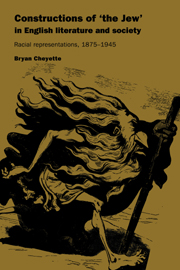Book contents
- Frontmatter
- Contents
- Preface
- Acknowledgements
- 1 Introduction: semitism and the cultural realm
- 2 The promised land of liberalism: Matthew Arnold, Anthony Trollope and George Eliot
- 3 Empire and anarchy: John Buchan and Rudyard Kipling
- 4 The ‘socialism of fools’: George Bernard Shaw and H. G. Wells
- 5 The limits of liberalism: Hilaire Belloc and G. K. Chesterton
- 6 Modernism and ambivalence: James Joyce and T. S. Eliot
- 7 Conclusion: semitism and the crisis of representation
- Bibliography
- Index
7 - Conclusion: semitism and the crisis of representation
Published online by Cambridge University Press: 19 October 2009
- Frontmatter
- Contents
- Preface
- Acknowledgements
- 1 Introduction: semitism and the cultural realm
- 2 The promised land of liberalism: Matthew Arnold, Anthony Trollope and George Eliot
- 3 Empire and anarchy: John Buchan and Rudyard Kipling
- 4 The ‘socialism of fools’: George Bernard Shaw and H. G. Wells
- 5 The limits of liberalism: Hilaire Belloc and G. K. Chesterton
- 6 Modernism and ambivalence: James Joyce and T. S. Eliot
- 7 Conclusion: semitism and the crisis of representation
- Bibliography
- Index
Summary
The history of the Chosen people is full of such contretemps but they survive and thrive. … And look at them in the railway carriage now. Their faces are anxious and eloquent of past rebuffs. But they are travelling First.
E. M. Forster, Pharos and Pharillon (London, 1923), p. 29 (after witnessing a verbal assault on a British-Jew)I object as much to semitism in matters of mind as in matters of commerce.
Ezra Pound, letter to Wyndham Lewis, in Timothy Materer (ed.), Pound/Lewis: The Letters of Ezra Pound and Wyndham Lewis (New York, 1985), p. 218A central argument of this study is that the racial construction of ‘the Jew’ in English literature and society is far from being a fixed, mythic stereotype as is commonly thought. On the contrary, we have shown that writers do not passively draw on eternal myths of ‘the Jew’ but actively construct them in relation to their own literary and political concerns. This active remaking of Jewish racial difference resulted in a bewildering variety of contradictory and over-determined representations of ‘the Jew’ which were particularly threatening to those who would wish to exert a sense of control and order over an increasingly unmanageable ‘reality’. It was in these terms that a more general crisis of representation could be reflected in a semitic discourse which constructed ‘the Jew’ as both within and without; a stranger and familiar; an object of esteem and odium; a progressive universalist and a racial particularist.
- Type
- Chapter
- Information
- Constructions of 'the Jew' in English Literature and SocietyRacial Representations, 1875–1945, pp. 268 - 275Publisher: Cambridge University PressPrint publication year: 1993



